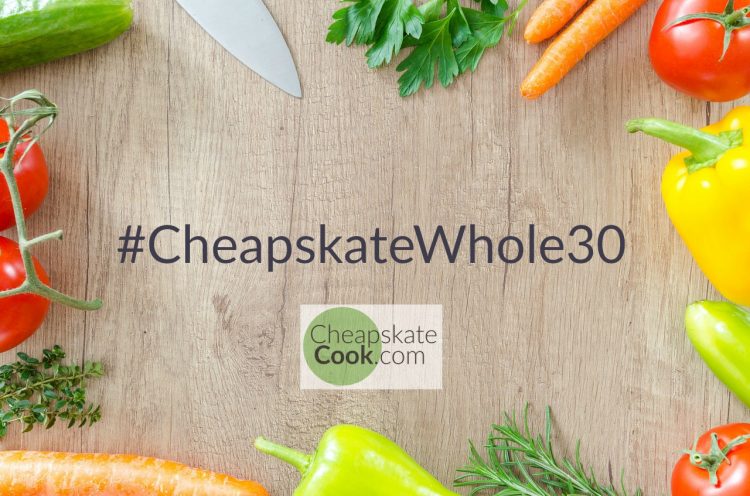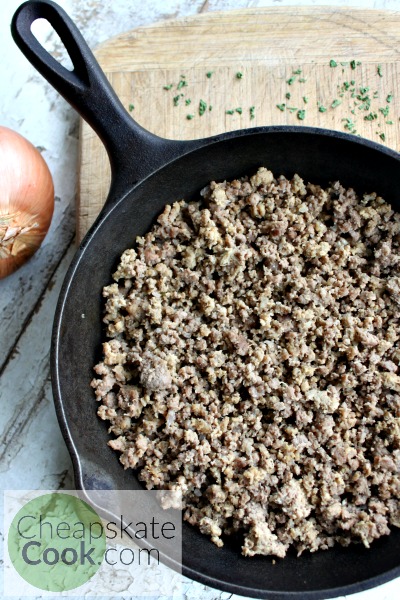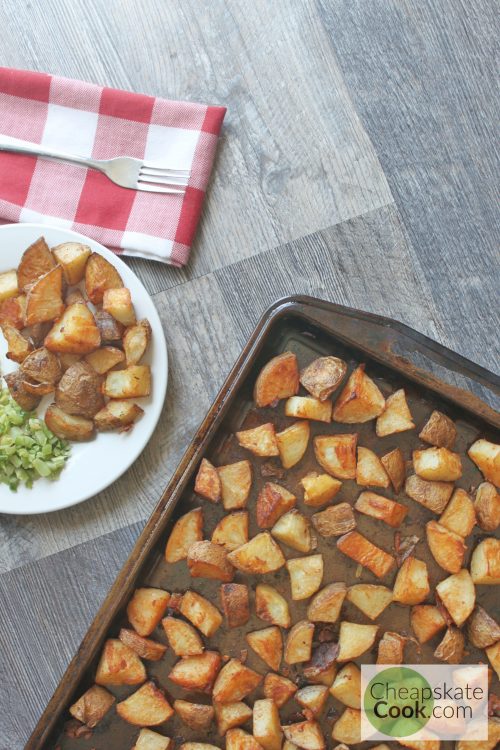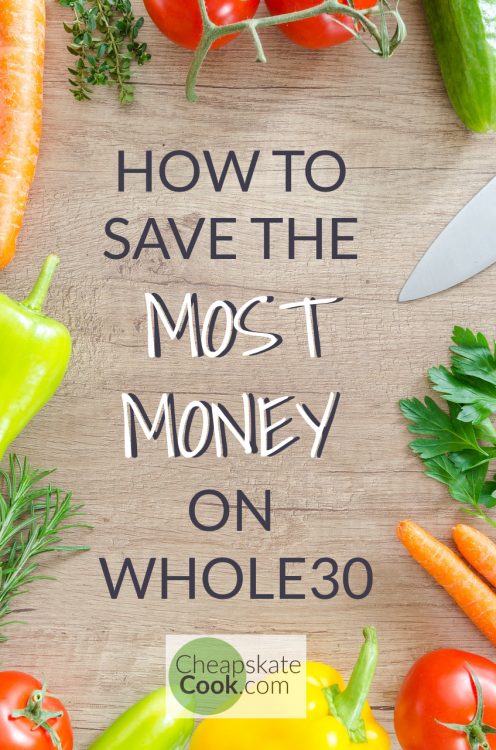Our goal was to save as much money as possible while on Whole30. As a growing family of 5 big eaters, using all of these strategies saved us A LOT of money. If you’re going to try Whole30 on a tight budget, these frugal tips will help you do it.

Last month, our entire family tried Whole30 for the first time. As a family of 5, we already go through a lot of food. I would venture to claim that we go through more food than the average family with 3 kids.
Some people give birth to precious children who eat half a peanut butter sandwich and baby carrots. And some kids are locusts. Guess which ones we have.
The problem is that when you remove cheap starchy fillers – like rice, oatmeal, crackers, chips, and bread – and substitute them with meat and vegetables, your budget changes. Significantly.
Normally, my family lives off of the same amount of grocery money we would receive if we were on food stamps. We could spend even less – and have spent a lot less in the past – but this is where our budget is right now. We eat mostly organic, local meat products, a lot of organic produce, and try to avoid GMO’s and artificial colors or preservatives in our food. In order to save money and eat so clean, we live on mostly plant-based meals. Whole30 challenged us to eat differently.
We started Whole30 because of some recent health issues. But we wanted to do it without breaking the bank. So we called it the #CheapskateWhole30 Experiment.
My goal was to challenge myself to tackle important things like gut healing and food allergies without spending an exorbitant amount of money.
We had no idea if we could do it.
Full Disclosure
Halfway through Whole30, we had a major family emergency (if you get my emails or follow me on Instagram or Facebook, you likely heard more about it), and we had to wrap it up early. We made it to Day 20.
So I won’t say we actually did Whole 30. We made it most of the way; we learned a lot; we had 3 weeks of grocery trips and menu plans to practice money-saving ideas. But we did not get to finish it, and now we’re on a journey where we probably won’t pick it up again for awhile.
That being said, we were on a steady roll and were all set to finish strong. These tips can help you no matter where you are on your Whole30 or how long you actually get to stick to it.
Do all the normal money saving things:
Menu plan, compare prices, shop at multiple stores in order to find the best price, etc. These are all basics of grocery store savings that you can and should apply to your Whole30 in order to save the most money.

Don’t Just look at the Grocery Store
Sometimes the grocery store doesn’t have the best price – especially if you’re trying to eat organic meat or local produce.
In order to save money on meat, we pulled from these ideas and found rock-bottom prices on clean meat.
In order to get the best prices on produce, we used these ideas.
Keep it Simple, Sugar
Our meals were basic – sweet potatoes or potatoes, steamed veggies or salad, and a little bit of meat. Or a hearty stew made with homemade bone broth, vegetables, and potatoes.
Soup & Stew
This makes Whole30 more appealing in the winter – you can make huge pots of soup. When I wasn’t just tossing leftovers into a big pot and calling it a meal, we liked these frugal, Whole30 recipes:
Beef & Veggie (Hamburger) Soup
Picadillo (Mexican Ground Beef & Potato Stew)

Flavorful, Homemade Basics
Rather than pay top dollar for Whole30-compliant bacon or sausage, we made this clean, 4-ingredient sausage from ground beef or turkey. It was one of our favorite parts of Whole30.
Crispy Baked Home Fries & Deeply Flavorful Baked Sweet Potatoes provided the starchy backbone of nearly every meal, especially for the kids.
Simple Condiments
You can spend a lot of money on Whole30-compliant condiments. This is because nearly every conventional condiment has sugar or other banned ingredients.
We saved a lot of money by sticking to the basics – it’s only 30 days. We can live without ketchup for that long #firstworldprobs. We did waste a little bit of money on trying some homemade alternatives, but it was worth a shot.
Here’s what we used:
Homemade Mayonnaise – mixed it with herbs and spices to create other sauces and dressings
Homemade Greek Dressing (recipe coming)
Mustard (check ingredients for no artificial color!)
Check out Aldi
Aldi is a veritable treasure trove of Whole30-compliant food. Aside from fantastic prices on fruits, vegetables, and meat, we found these as well – all without sugar or artificial dyes! (Go here to see the real food we buy there when we’re not on Whole30)
- Olives – black, kalamata, and Spanish
- Banana Peppers
- Dill Pickles
- Lunchmeat
- Spaghetti Sauce
- Spices
- Olive oil
- Almond Milk
- Mustard
Shop Clearance & Markdowns
Halfway through our Whole30 – Whole20, whatever – a friend challenged me to try something new. We needed to get even more creative saving money while on Whole30. So I tried shopping the clearance and markdown items at our local Kroger.
I was really impressed with the results. It takes some patience and practice – some days I found a lot, and some days I hardly found anything.
2 Rules When Shopping for Markdowns (Whether on Whole 30 or Not):
- Discover what days your store has the most markdowns. This might involve asking multiple employees (I usually get several different answers before I figure out the real day 😜). Or it might mean popping in every day for a week or so before you see the trend. It can be a small time investment for big savings.
- Go in the early to mid-morning. I know this isn’t possible for all of us, but this time frame is usually best for finding markdowns before they’re all bought up.
How to Find Markdowns for Whole30:
Because Whole30 is essentially produce and protein, you only need to visit those two sections of the store. I start in the produce, sweep the perimeter of the refrigerated section, then stop by the free kids’ basket (where kids can pick a free piece of fruit!) and the center markdown produce rack. At Kroger, it’s usually a low shelf next to the nuts and bananas.
They have red netted bags that usually cost 99 cents each are full of anything from the produce section that needs to be sold now – apples, oranges, potatoes, peppers, avocados, etc. Overripe bananas in that section cost 39 cents/pound.
Next you’ll want to hit the meat section, Avert your eyes as you walk through the bakery and try not to daydream about bread.
Quite often the markdowns are clumped together on a shelf, but often you’ll find a few more scattered throughout the shelves and giant refrigerated aisle boxes.
Lastly, hit the eggs section and natural foods aisle to check for markdown eggs.

Our goal was to save as much money as possible while on Whole30. As a growing family of 5 big eaters, using all of these strategies saved us A LOT of money. If you’re going to try Whole30 on a tight budget, these tips will help you do it.


Trackbacks/Pingbacks